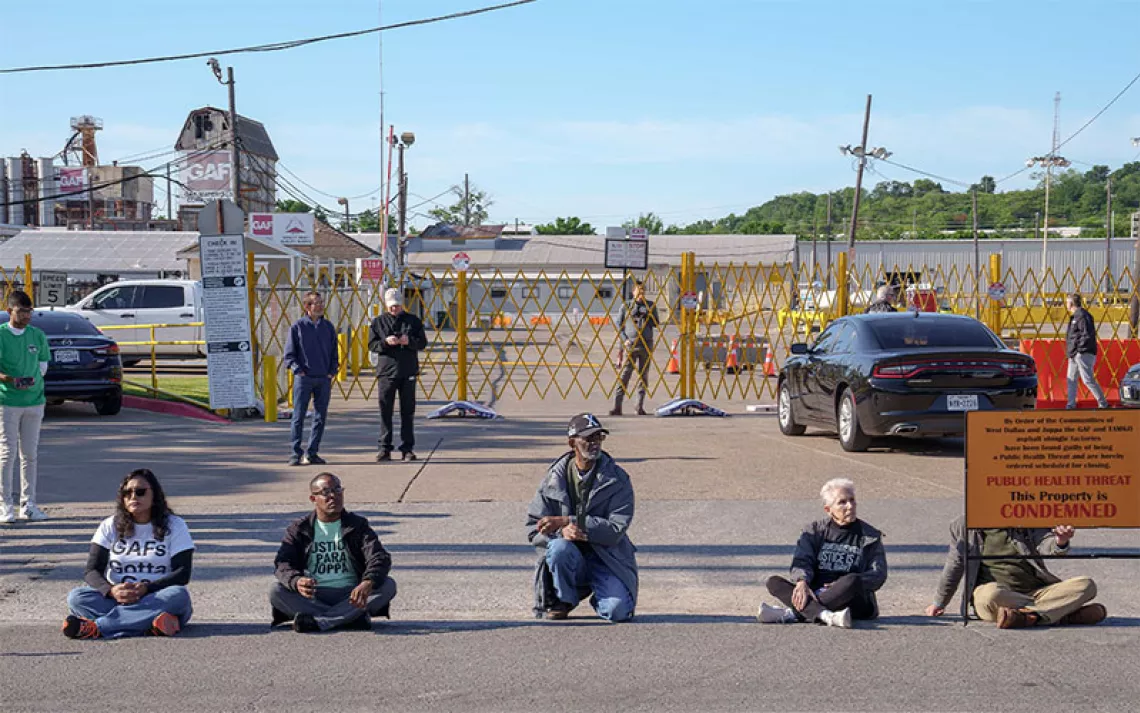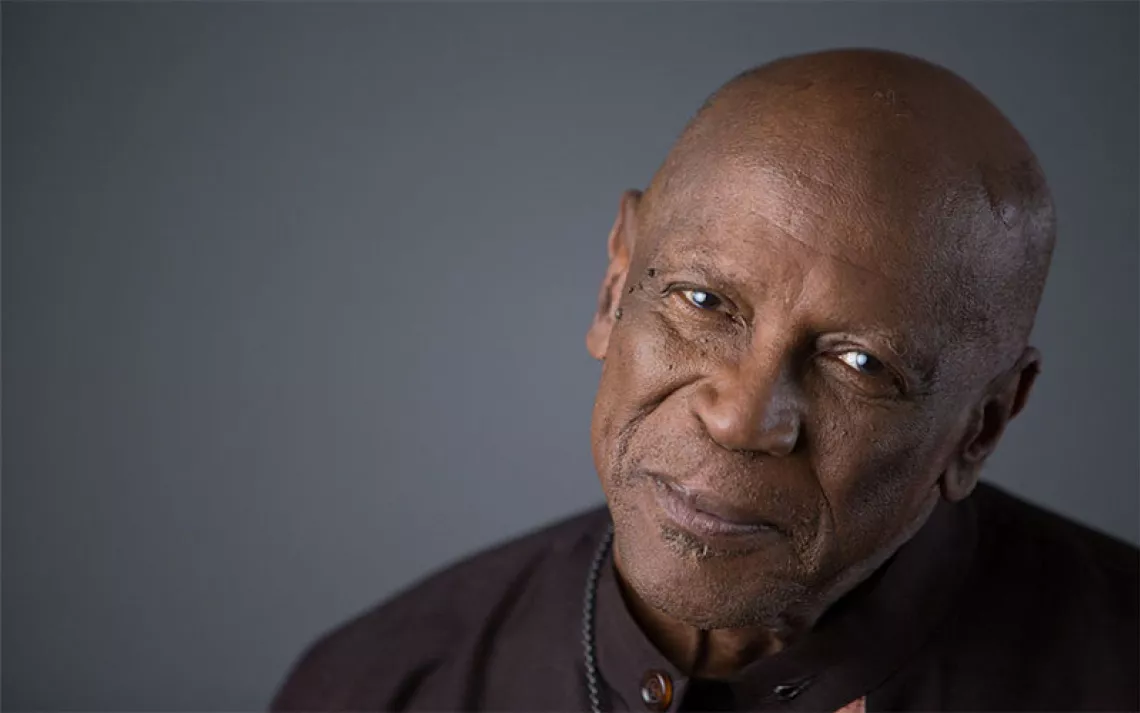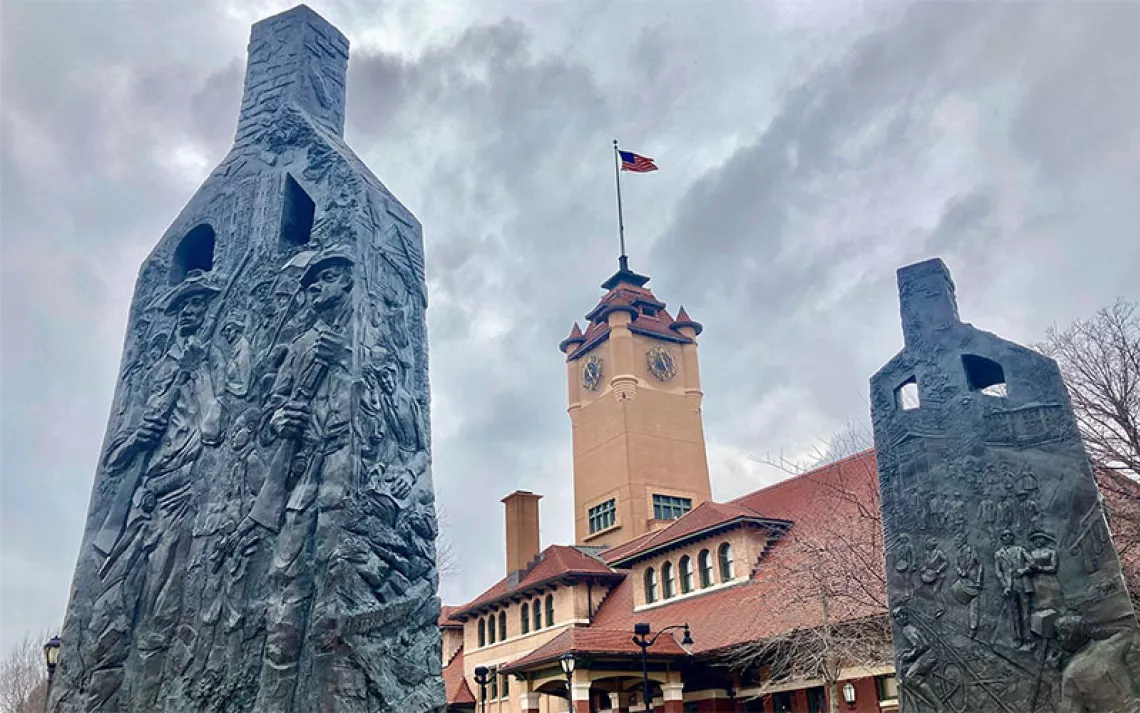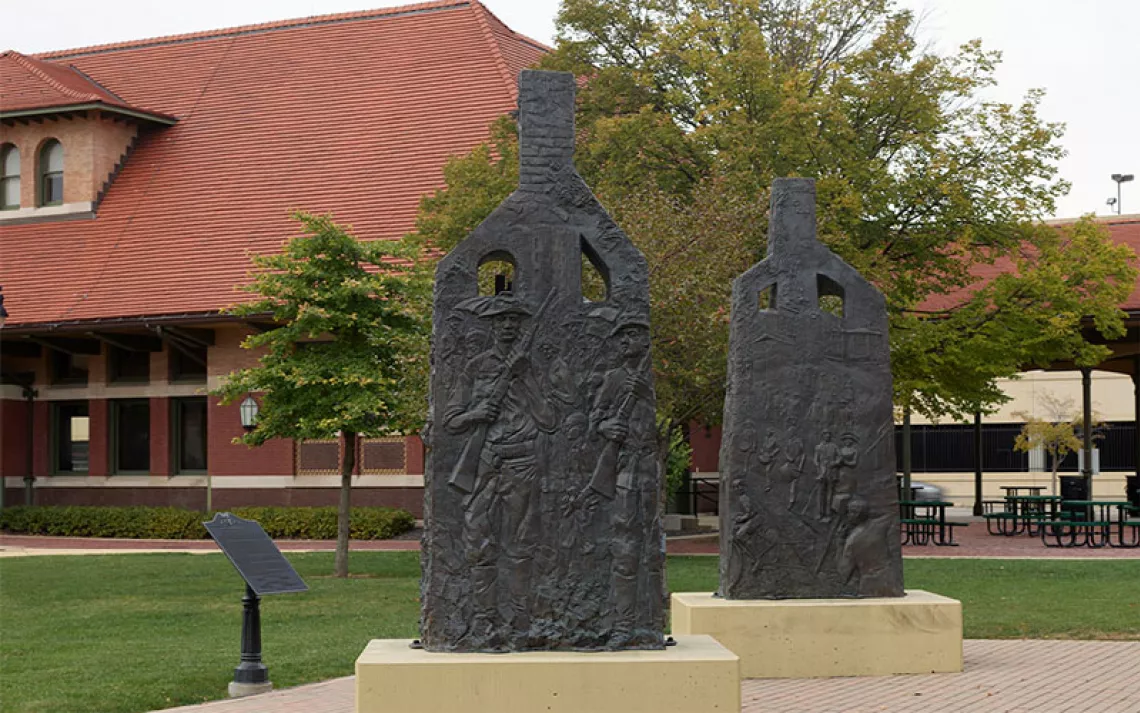Racial Justice Is Environmental Justice
The Sierra Club’s advocacy is intersectionality in action

Photo by Brian Feinzimer/Sipa USA via AP Images
In the year since the horrific murder of George Floyd by Minneapolis police officer Derek Chauvin, the gruesome footage captured that day has been seen around the world and replayed countless times. Those of us who have been unjustly threatened, detained, intimidated, assaulted, and arrested by the police have been retraumatized by that internet-broadcast lynching—just as we’ve been retraumatized by the deaths of 181 Black people at the hands of the police that occurred in the United States between Floyd’s murder and Chauvin’s conviction.
George Floyd—may he rest in power—is now a household name to people worldwide. Many of those other 181 Black people who died in the past year due to police actions aren’t so well known. Though mourned by their friends and family, their unnecessary and tragic deaths are unlikely to enter the history books. Each of them is, in a way, like Jamar Clark—a Black man who was shot and killed by Minneapolis police in 2015.
I want to tell you about Clark because each and every person who dies at the hands of the police deserves to be remembered. And, as the national director of policy, advocacy, and legal at the Sierra Club, I want to tell you about the response to Clark’s death because it’s such a powerful example of solidarity between communities of color and legacy, historically white-run organizations like the Sierra Club.
As the Jamar Clark story shows, demanding progressive social change is nothing new for the Sierra Club. Demanding justice for Black and brown people who experience environmental racism is nothing new for the Sierra Club. Demanding justice for Black and brown people dying at the feet of police while being detained is also not new for the Sierra Club.
Whether it’s in Minneapolis or New Orleans or Chicago or Standing Rock, the communities that are overpoliced are also the same communities that are overburdened by toxic pollution. Those communities are suffering from a syndemic—many epidemics happening all at once—as they grapple with the threat multipliers of racial injustice from the legacy of white-settler supremacy, genocide, slavery (Native and African enslavement), racial terrorism, segregation, redlining, land loss, gentrification, climate change, and health disparities. The life and untimely death of Jamar Clark is just one example.
On November 15, 2015, Jamar Clark, a 24-year-old African American man, was shot by Minneapolis police. The shooting occurred on the same street where Karen Monahan, who was then the Sierra Club’s healthy community environmental justice organizer, had an office in the Minneapolis Urban League. The neighborhood of North Minneapolis was then—and remains today—a clear example of how environmental racism plays out. At that time, the main source of pollution in that community was Northern Metals’ metal scrap shredder—a facility that has since been shut down after its owners admitted to falsifying pollution records. Today, pollution in the area remains a concern, especially pollution from the Hennepin Energy Recovery Center, a waste-to-energy incinerator that burns trash to make electricity. In 2015, the Minnesota Pollution Control Agency recorded elevated levels of lead and other heavy materials in the area. The community within the zip code of 55411 has the highest rate of asthma hospitalizations in Minnesota. Almost half of that zip code’s population is African American, and nearly nine in 10 students in 55411 public schools receive or are eligible to participate in free or reduced lunch programs.
Community members protested Clark’s killing at the Fourth Precinct police station in the November cold. The temperatures were so freezing, they had to build fires to keep warm. Monahan and members of the Sierra Club’s North Star Chapter participated in the protests, which lasted for 18 days. The Sierra Club’s Healthy Communities program also provided in-kind solidarity by providing space heaters to the justice protesters.
In some ways, the 2015 protests over Jamar Clark’s killing were a glimpse of what would happen five years later. The Movement for Black Lives and related organizations had already shown themselves to be a potent force as justice organizers shut down Interstate 94, protested at the Minneapolis–St. Paul airport, and also at the iconic Mall of America. Yet official impunity remained the rule. The police who killed Jamar Clark were never charged; his family had to accept a civil settlement from the city.
When George Floyd’s execution sparked worldwide protests, the Sierra Club, like many organizations, produced a number of solidarity statements. We condemned the white-supremacist-in-chief Trump’s state-sanctioned violence against protesters and called for an investigation into the use of force against peaceful protesters right outside the White House. We published a major essay, “Racism Is Killing the Planet,” that made the connections between white supremacy and ecocide.
But we knew that statements are only worth so much. What was really needed was action, and for the Sierra Club to leverage its power and position to help accelerate the push for accountability and justice. At the request of our allies in the racial justice movement, the Sierra Club endorsed federal legislation including HR 40, which called for reparations for the descendants of enslaved Africans; HR 7085, which would end qualified immunity for police officers accused of wrongdoing; and HR 7143, which would demilitarize local law enforcement. Additionally, Sierra Club chapters from Georgia to California worked to promote legislation to reform the criminal justice system.
The Sierra Club was able to credibly support such pieces of proposed legislation and related policies because of the many years of partnership with social justice organizations and our deep experience with environmental justice. It was more important than ever that the Sierra Club took the lead from communities and organizations that had been working on these issues for years, if not decades. Solidarity meant stepping aside to play a supportive—not a leading—role.
Meanwhile, Sierra Club staff—including deputy legislative director Mahyar Sorour, who was engaged in the 2015 racial justice protests in Minneapolis; Lina Francis, deputy chief of communications; and consultant Carlton Mayers II, Esq.—worked to inform our longtime members, chapters, and board members about the connections between racial justice and the Sierra Club’s other areas of advocacy. Fighting climate change, divesting from fossil fuels, and working to end environmental racism go hand in hand with defunding the police in the fight for racial justice. A clear example of this is the ways in which police foundations across the country partner with corporations to raise money to supplement police budgets and purchase high-tech weaponry that law enforcement then uses with little public oversight.
As researchers from ProPublica and LittleSis.org have established, local police foundations and some of the biggest names in corporate America are closely intertwined. These police foundations raise money to buy weapons, equipment, and surveillance technology for police departments—weapons purchases that have little public input or oversight. That funding comes on top of the $100 billion spent nationally on policing every year; major cities in America typically spend 20 to 47 percent of their general budgets on police departments. The corporations that are backing police foundations cover a wide range of industries. Fossil fuel financiers such as Bank of America, Goldman Sachs, Wells Fargo, Black Rock, and SunTrust Bank contribute to police foundations. So do utilities such as DTE, Georgia Power, Duke Energy, Dominion, and Exelon. Fossil fuel companies such Shell, Chevron, Valero, and Marathon also fund police foundations.
These foundations create a public-private structure wherein the corporate elite can overtly support police departments through direct donations, sponsorships, and special programs, and by serving as directors on foundations’ boards. The ongoing racial justice protests of the past year have emphasized that police exist to enforce a racist social order that protects corporations, capital, and buildings rather than Black and brown lives. Police foundations are a key space for orchestrating, normalizing, and celebrating the collaboration between corporate power and the police.
The conflicts of interest between these foundations’ corporate sponsors and the technology, equipment, and training they are providing for local police departments have left us with an increasingly militarized police force that works under the mandate of unaccountable corporate donors. Police act as the corporate donors’ personal security. By way of example, just look at the way that fossil fuel corporations have been behind the militarized police response to Indigenous water protectors’ resistance to the Line 3 pipeline in Minnesota.

Demonstrators rally at the Government Center in Minneapolis during a protest over the fatal police shooting of Jamar Clark on March 30, 2016. | Photo by AP Photo/Jim Mone
Meanwhile, Republican lawmakers in state legislatures are trying to further criminalize dissent. GOP legislators in 34 states have introduced 81 anti-protest bills during the 2021 legislative session. Many of these retrograde laws came in reaction to the protests against the murders of George Floyd and other Black and brown people. They will also make it more difficult for environmental activists to oppose fossil fuel projects like pipelines, oil drilling, coal mining, and gas export terminals. These proposed (and, in some cases, already enacted) laws will criminalize communities’ ability to exercise their free speech rights.
The aggression of the police and the criminalization of dissent show why we need to divest from militarized policing and reimagine public safety. Real public safety, in the Sierra Club’s view, means investing in housing, infrastructure, education, and clean energy instead of the millions of dollars that would otherwise go to surveillance equipment, armor vehicles, and weapons.
For our part, the Sierra Club is reenvisioning and reimagining public safety via the THRIVE Agenda (Transform, Heal, and Renew by Investing in a Vibrant Economy), which was introduced to great fanfare in April. This “build back better” package, crafted by the Green New Deal Network, aims to, among other things:
- Avert climate and environmental catastrophes
- Upgrade our broken infrastructure
- Build clean and affordable public transit
- Replace lead pipes to provide clean water
- Expand wind and solar power
- Increase jobs, wages, and benefits for the work of caring for children, the elderly, and the sick
- Modernize buildings to cut pollution and costs
- Protect and restore wetlands, forests, and public lands
- Support family farmers, agricultural workers, and rural communities
- Create high-skill, high-wage manufacturing jobs by expanding manufacturing of clean technologies
- Build the power of workers to fight inequality
- Invest in Black, brown, and Indigenous communities
- Strengthen and heal the nation-to-nation relationship with sovereign Native nations
- Combat environmental injustice and ensure healthy lives for all
This work—which is led by Ben Beachy and the Sierra Club’s Living Economy program—has sparked an outpouring of grassroots activism. Sierra Club activists have led over 250 THRIVE Town halls, rallies, and other events from West Virginia to Guam. They have made thousands of calls and sent thousands of messages to members of Congress in support of the THRIVE Agenda.
The Sierra Club works with people from all walks of life—from prison and police abolitionists to legacy civil rights groups, environmental justice groups, faith-based organizations, young people, unions, and old-school conservationists. These cross-sector alliances have spurred us to reimagine public safety amid these syndemics—and also to imagine new ways to incorporate justice in our long-standing efforts to enjoy, explore, and protect the planet.
 The Magazine of The Sierra Club
The Magazine of The Sierra Club



